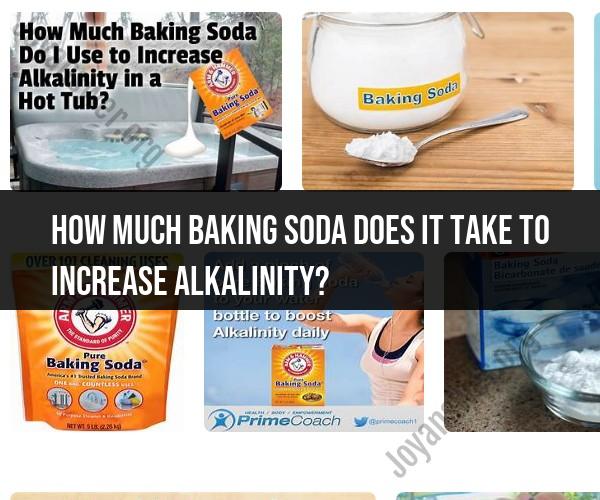How much baking soda does it take to increase alkalinity?
The amount of baking soda (sodium bicarbonate) required to increase alkalinity in a specific solution, such as water or a cooking recipe, depends on the volume of the solution and the target alkalinity level you want to achieve. Here are some general guidelines for using baking soda to increase alkalinity:
1. Determine the Initial Alkalinity:
- Measure the initial alkalinity of the solution using a pH test kit or pH meter. Alkalinity is typically expressed in terms of pH or total alkalinity (TA).
2. Calculate the Required Amount:
- Calculate the amount of baking soda needed to reach your desired alkalinity level based on the volume of the solution and the change you want to make.
- You can find alkalinity adjustment calculators online or refer to the instructions on the packaging of your pH test kit.
3. Gradual Addition:
- Add baking soda gradually in small increments to avoid overshooting your target alkalinity. Stir or mix the solution thoroughly after each addition.
4. Recheck Alkalinity:
- Recheck the alkalinity using the pH test kit or pH meter to ensure you've reached your desired level.
5. Factors to Consider:
- Keep in mind that the specific amount of baking soda required can vary based on the concentration of your baking soda, the volume of the solution, and the initial alkalinity. Be cautious not to add too much, as excessive alkalinity can lead to an unpleasant taste in food and drinks.
6. Safety and Guidelines:
- Baking soda is safe for consumption in reasonable quantities, but it's essential to follow recommended guidelines and not exceed safe limits.
- For culinary purposes, start with small amounts of baking soda (e.g., a pinch) and gradually adjust to taste.
- When using baking soda for cleaning or other non-food applications, always follow the manufacturer's instructions and safety guidelines.
7. Seek Professional Advice:
- If you are adjusting the alkalinity of water for specific purposes, such as in a swimming pool or aquarium, consult with a professional or follow guidelines specific to those applications, as they may require more precise measurements and considerations.
Keep in mind that baking soda is sodium bicarbonate, and excessive consumption of sodium can have health implications, particularly for individuals with certain medical conditions. Always use it in moderation and in accordance with recommended guidelines for your specific application. If you have concerns about using baking soda for health-related purposes, consult with a healthcare professional.
Adjusting Alkalinity with Baking Soda: Dosage and Guidelines
Baking soda, also known as sodium bicarbonate, is a common household product that can be used to raise the alkalinity of water. Alkalinity is a measure of the water's ability to resist changes in pH. It is important to maintain a proper alkalinity level in pool water to prevent the pH from becoming too acidic or too basic.
To adjust alkalinity with baking soda, simply dissolve it in the pool water and circulate it thoroughly. The amount of baking soda you need to add will depend on the size of your pool and the current alkalinity level. A good rule of thumb is to add 1 pound of baking soda for every 10,000 gallons of pool water to raise the alkalinity by 10 ppm.
Here are some tips for adjusting alkalinity with baking soda:
- Dissolve the baking soda in a bucket of water before adding it to the pool. This will help to prevent the baking soda from forming a cloud in the pool water.
- Add the baking soda evenly around the perimeter of the pool.
- Circulate the pool water for at least 2 hours after adding the baking soda to ensure that it is dissolved and evenly distributed.
- Test the alkalinity level of the pool water again after 24 hours to make sure that it is at the desired level.
The Impact of Baking Soda on Water Temperature: Fact or Myth?
There is a common myth that baking soda can raise the temperature of water. However, this is not true. Baking soda does not have any direct effect on water temperature.
The exothermic reaction that occurs when baking soda is dissolved in water produces a very small amount of heat. However, this amount of heat is negligible and will not have a noticeable effect on the temperature of a large volume of water, such as a pool or hot tub.
Balancing Water Chemistry: Baking Soda and Pool Alkalinity
Maintaining a proper alkalinity level in pool water is essential for preventing problems such as corrosion, scale buildup, and algae growth. Baking soda is a safe and effective way to raise the alkalinity of pool water.
When adding baking soda to pool water, it is important to follow the dosage and guidelines provided above. Adding too much baking soda can raise the alkalinity level to an unsafe level, which can cause problems such as cloudy water and skin irritation.
By regularly testing the alkalinity of pool water and adding baking soda as needed, you can help to maintain a balanced water chemistry and keep your pool looking and feeling its best.











